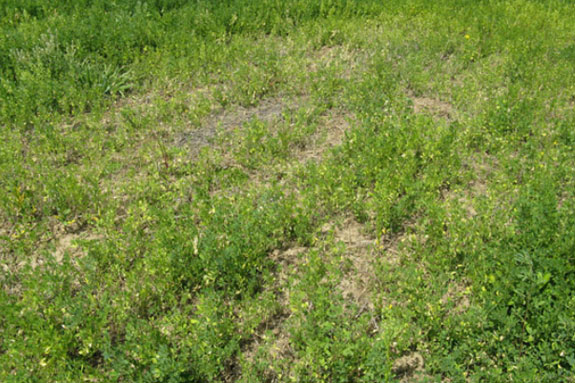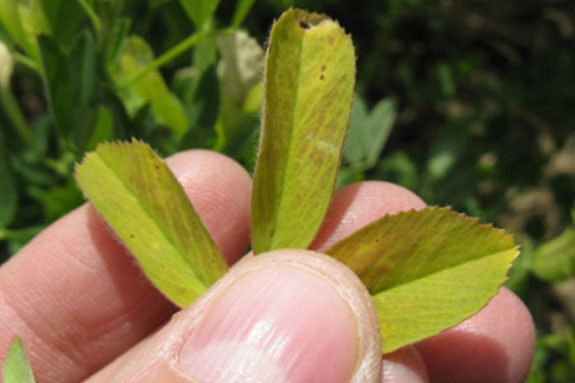While alfalfa is not widely cultivated in Illinois, for those who have fields planted with this crop and have seen problems, this article may be useful.
In Illinois the crop most sensitive to boron deficiency is alfalfa; deficiency in corn or soybean is extremely rare because those crops have low boron requirements.
In fact, the most common problem for corn with boron is toxicity if a large amount was applied to an alfalfa stand the year before corn. Boron deficiency in alfalfa is most common in sandy soils that are low in organic matter or in soils with high pH.
Often boron deficiency appears during droughty conditions because the lack of water reduces the capacity of organic matter to release boron. Boron does not easily translocate in the alfalfa plant and, as a result, the deficiency appears as yellow-reddish leaves in the top portion (new growth) while the older leaves remain green. The deficiency has thus come to be referred to as "yellow top."
Later in the season, similar symptoms can be produced by leafhopper damage, which is often misdiagnosed as boron deficiency. An easy way to separate the two problems is to look for flowers. If the problem is caused by leafhopper, alfalfa will flower, whereas flowering is unlikely if boron is deficient.
Also, boron deficiency negatively impacts cell development in alfalfa, often resulting in shorter internodes and bunching of top leaves. If the deficiency is severe, growing points may die.
It is somewhat unusual to see boron deficiency symptoms this early in the growing season – typically they appear on the second or third cuttings of alfalfa, especially during droughty periods. I suspect the reason for boron deficiency in some fields so early is that it has been unusually dry, especially for sandy soils that have lower capacity to retain water.
If you suspect boron deficiency in an alfalfa field, you can investigate the problem in several possible ways. First, remember that boron deficiency may be induced by dry conditions; as the soil receives more moisture, the deficiency likely will disappear. That said, deficiency symptoms may indicate that boron levels are marginal for the soil.

Most soil tests for micronutrients are not reliable tools, but I do have enough confidence in the soil test for boron in alfalfa fields to recommend it. In fields showing suspect boron deficiency, I recommend taking soil samples for analysis. A hot-water extraction result of less than two lbs B per acre indicates a need to apply boron.
Another alternative to determine whether boron is a problem is to sample the top six inches of the plant at early bloom. If boron concentration in the tissue is less than 25 ppm, a boron application would probably help.
Since deficiencies typically appear in patches in the field, take samples from both the affected and the unaffected areas and analyze them separately.
Finally, take a look at the crop roots to assess whether other problems may be causing the deficiency symptom. Sometimes a deficiency observed in the canopy has little to do with the amount of nutrient supplied by the soil but a lot to do with the condition of the roots. If soil properties or other factors are reducing root growth, this can affect the plant's ability to tap into nutrients and water.
If investigation reveals clearly that remedial action is needed, I recommend applying boron. Unless soil testing indicates that concentrations are marginal in the areas that do not show visual deficiency symptoms, restrict the application to only the affected area rather than treating the entire field.
Applying 30 lbs per acre of household borax (3.3 lbs B) can be a viable alternative. If a deficient field needs other nutrients, like P or K, it might be easier to apply the small amount of boron by mixing the product with the other fertilizer.
In sandy soils, for alfalfa production I suggest yearly applications of one to two lbs B per acre. For fine-textured soils that have boron deficiency, an application of three to four lbs B per acre the year of establishment is typically sufficient to correct the problem for a few years.
The only caution is that if oats accompany alfalfa during establishment, the boron application should be delayed until after the first year to avoid toxicity problems for the oats.
Similarly, to avoid boron toxicity for corn, I would not apply boron to alfalfa the year before corn will be planted. Finally, if a foliar treatment is preferred, a rate of 0.1 to 0.3 lb B per acre is normally all that would be needed to correct the problem. Always make sure to read and follow the product label. FG
—From University of Illinois Department of Crop Sciences
PHOTOS
TOP: An alfalfa trifoliate with symptoms of possible boron deficiency.
BOTTOM: An alfalfa patch exhibiting what appears to be boron deficiency. Photos by Angie Peltier, University of Illinois Extension.












